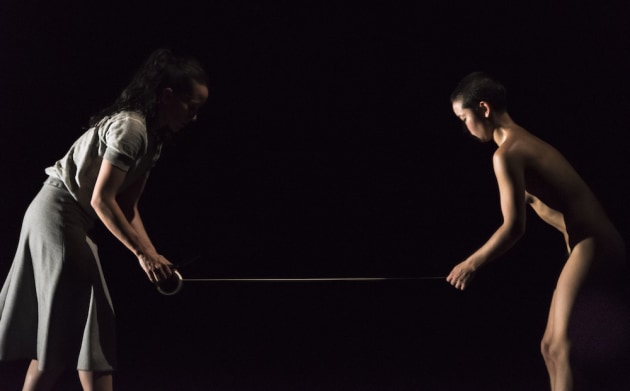Adelaide College of the Arts Main Theatre, 3 March
Adelaide-born choreographer Lucy Guerin’s two-women show, Split, premiered at Dance Massive in 2017 and rapidly garnered an impressive array of nominations, with performer Lilian Steiner winning a Helpmann Award for Best Dancer. Apart from a showing at the Australian Performing Arts Market in 2017, this season in the Adelaide Festival of Arts is the first time the work has been seen outside Melbourne, and it is easy to see why it has generated such a buzz.
As the lights go up the pounding heartbeat-like score by UK sound artist Scanner becomes louder. Two women are revealed upstage, one clothed in a dress (Melanie Lane) and one naked (Lilian Steiner). In the long duo that follows, their angular movements are almost incredibly synchronised. Small hand gestures and swinging movements of the torso and arms morph into small jumps and turns, then ever-larger movements such as a long sequence of gallops encompassing the whole space. In this first section the pair seem to be doubles, always in perfect unison but neither making eye contact nor even facing each other.
Suddenly they step out of character to pick up some white gaffer tape with which they mark off one half of the floor. In the next section their movement is confined to one of these sections, and in each subsequent section the available space shrinks by half, until they are confined to a tiny area upstage only just big enough to stand in. The length of the sections shrinks accordingly, with the final one a mere moment. Each transition is marked by the same ritual of Steiner using a towel to wipe the sweat off her body and then both dancers laying the tape across the floor. Paul Lim’s lighting design switches from side lighting to down spots and so forth, very effectively alerting us to the changing dynamic between the dancers.

For if this work can be said to be about anything it must surely be an investigation into the nuances of relationship. In some sections the dancers relate harmoniously, caressing and cradling each other. Sometimes they watch each other intently, only to completely ignore each other in the next section. Other sections are marked by gestures of aggression and violence, as they slap and hold each other down, even occasionally pinning each other to the ground with their feet or yanking each other by the hair. The dynamic changes from supplication to dominance as each in turn seeks to consume and control the other.
The audience is left trying to understand if this is a metaphor for something: are they aspects of the same personality split asunder? Are they lovers oscillating between tenderness and hostility? Are they adversaries fighting off their own weaknesses? One might think that the nakedness of Steiner would add an element of vulnerability, but Guerin’s choreography never takes the expected path and the work is continually surprising. Nakedness is as much about power and freedom here as it is about exposing frailties. Both dancers are magnificent, totally absorbed in the work, but Steiner’s ability to dance with her naked body fully exposed for the entirety of the piece without sexualisation or embarrassment is truly remarkable. At roughly forty-five minutes, Split remains riveting from beginning to end.
Maggie Tonkin
Pictured top are Melanie Lane and Lilian Steiner in Split. Photo: Gregory Lorenzutti.



